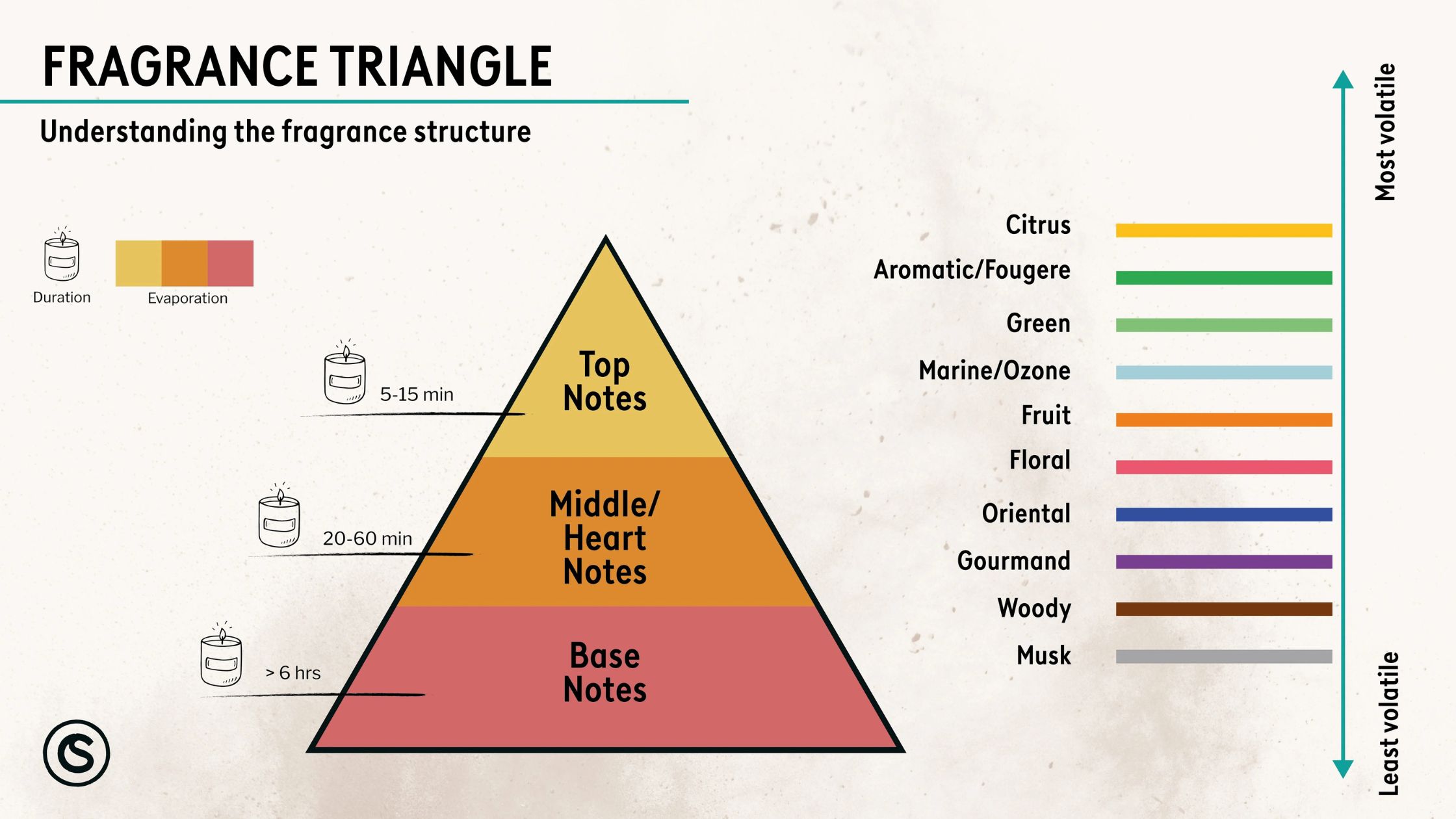Perfume fragrance notes unfold in three distinct layers on your skin, each with its own lifespan. The first impression lasts only 5-15 minutes. The deepest notes can stay on your skin for six hours or more.
Learning about perfumery makes understanding scent layers crucial. The olfactory pyramid has top, middle, and base notes that each play a unique role in the fragrance experience. Top notes create that first impression but evaporate quickly. Middle notes become the fragrance’s heart and last 20-60 minutes. Base notes provide the lasting foundation that brings everything together. These base notes have a heavier molecular structure and are the least volatile components of any fragrance.
This piece explains everything about perfume notes in simple terms. You’ll discover what makes a fragrance special, from first impressions to lasting memories. The knowledge will help you identify different scent layers. Your appreciation for perfumes will grow deeper as you learn to create your signature scent. These fundamentals will change your fragrance experience completely.
Understanding Perfume Notes
Perfume goes beyond a pleasant scent—it’s a carefully arranged composition of fragrance notes that creates a complete experience for your nose. You’ll appreciate the artistry behind your favorite fragrances better when you understand these notes. Maybe even create your own signature scent.
What are notes in perfume?
Perfume notes describe scents that you notice when you apply a perfume. These components build the overall scent profile and create what perfumers call the “perfume accord”—the simple character of a fragrance. Notes work as individual scent layers of ingredients that blend into a complete fragrance experience.
Perfumes work like symphonies of scent, not single-note melodies. One note can change how we see another—to name just one example, base or heart notes will affect how top notes smell, which creates a unique sensory experience.
The olfactory pyramid explained
The olfactory pyramid helps us understand how perfume notes stack up based on their volatility and staying power. Notes at the pyramid’s top fade fastest, while bottom notes last longer.
This pyramid has three distinct layers:
- Top notes (head notes) – You smell these right after application, and they last about 5-15 minutes
- Middle notes (heart notes) – These make up the fragrance’s core and emerge as top notes fade, lasting 20-60 minutes
- Base notes (soul notes) – These provide depth and longevity, lasting several hours to days
The pyramid doesn’t always move in a straight line. Notes often go together. Yes, it is common in well-made perfumes to smell heart notes mixed with top notes, or rich base notes from the first spray.
Why scent layers matter
Scent layers create an experience that changes throughout your day. Robin Mason, president of Fine Fragrance at dsm-firmenich, says “Layering will give you the most important part of the formula… your individual taste and the way your body responds to combinations”.
The layers let you express yourself. People in the Middle East started fragrance layering to create signature scents by mixing different fragrances. This ancient practice serves as the foundation of modern perfumery.
A balanced composition needs all three notes working together. Using too many dominant top notes can create an overwhelming start that quickly disappears, while too many base notes might become overwhelming. The magic happens when all layers interact in perfect balance.
Top, Middle, and Base Notes Explained
Perfume’s magic reveals itself through different notes that unfold over time. Each layer adds a unique element to your fragrance trip. The scent evolves from the first spray until its final traces hours later.
Top notes: First impression scents
Your first impression of a fragrance comes from top notes. These light molecules disappear quickly and last only 5-15 minutes after application. Top notes play a vital part in your attraction to a perfume, despite their brief appearance.
We composed these bright, fresh scents with:
- Citrus elements: Bergamot, lemon, orange, grapefruit
- Green accords: Peppermint, basil, spearmint
- Ozonic scents: Watery and airy fragrances
These notes know how to create that immediate “wow factor” before they gracefully transition to deeper layers.
Middle notes: The heart of the fragrance
Middle notes (or heart notes) emerge within 10-15 minutes as top notes fade. They dominate for about 20-60 minutes. A perfume’s character comes from these notes that make up 70% of the overall scent.
Heart notes bridge the gap between fleeting top notes and lasting base notes. Fuller and more rounded scents create the fragrance’s personality. Common heart notes include:
- Floral elements (rose, jasmine, ylang-ylang)
- Spicy components (cinnamon, cardamom, pepper)
- Fruity accords (peach, apple, strawberry)
Well-crafted perfumes blend middle notes with top notes that create uninterrupted transitions throughout the scent experience.
Base notes: The lasting foundation
Base notes are the foundations that anchor the entire fragrance. These notes appear within 30 minutes of application and last six hours on skin—sometimes days on clothing. Base notes’ heavy molecular structure makes them nowhere near as volatile as other components.
The fragrance’s true signature emerges as middle notes fade, leaving depth, warmth, and longevity. Common base notes include:
- Woody elements (sandalwood, cedarwood, patchouli)
- Oriental accords (vanilla, amber)
- Musk and powdery notes
Expert perfumers craft scents that hint at rich base notes from the start. These notes develop fully only after your trip through top and middle notes.
How to Blend Perfume Notes
Making your own perfume starts with learning to blend fragrance notes together. A harmonious composition emerges when different scent layers interact in the right way.
Simple ratios for top, middle, and base
Perfumers use several proven formulas to blend notes effectively. The most popular ratio follows the 30/50/20 rule—30% top notes, 50% middle notes, and 20% base notes. Some perfumers prefer a 3:2:1 ratio (top:middle:base) or a 4:2:1 distribution. Newcomers can achieve good results with a straightforward mix of 20% top notes, 30% heart notes, and 50% base notes.
Using the drop-by-drop method
Drop-by-drop blending gives you precise control over your perfume creation:
- Add one drop of your base note to a bottle
- Add one drop of middle note, swirl gently, and smell
- Add one drop of top note, swirl, and assess
- Add drops gradually and record each addition
Your blend needs a few days to settle—fragrances develop new characteristics over time.
Common note combinations for beginners
Some perfume notes naturally work together:
- Florals: Work beautifully with woody, citrusy or spicy oils
- Woody notes: Combine well with almost every category
- Citrus and cedar: Create a rich, juicy aroma
- Coconut and sandalwood: Pair sweet notes with earthy depth
- Vanilla and tonka bean: Make a deliciously sweet combination
Your journey should begin with single-note fragrances instead of complex blends.
Tips for Choosing and Evaluating Perfumes
Picking your perfect perfume takes more than a quick sniff at the store counter. You need the right testing approach and a good grasp of how scents develop on your skin to make smart choices.
How to test a fragrance properly
Blotter strips give you that first impression – just keep them about an inch from your nose. Your chosen scent should go on pulse points—wrists, neck, or inner elbows—where your body’s heat helps the perfume notes bloom. Don’t rub your wrists together after you spray, as this breaks down the fragrance and changes its true nature. Your nose can only handle about three fragrances at once, so stick to that limit.
Understanding how notes evolve on skin
Your skin’s chemistry affects how perfume notes develop by a lot. The sort of thing I love about scent behavior is that oily skin holds fragrances longer and works beautifully with oriental, spicy scents. Dry skin pairs better with citrusy and floral notes. A fragrance needs several hours to fully develop on your skin before you make that final call. Well-hydrated skin makes scents last longer, so a layer of unscented lotion before your fragrance works wonders.
Mistakes to avoid when buying perfume
Watch out for these common traps:
- Buying without testing on your skin first
- Keeping perfumes in bathrooms or sunlight
- Making choices based just on top notes without letting them develop
- Running after trends instead of what you truly like
It’s worth mentioning that a quality perfume shows its true colors through complexity and smooth transitions between top, middle, and base notes.
Conclusion
Becoming skilled at understanding perfume fragrance notes changes how we experience and choose scents. A trip through top, middle, and base notes shows why some fragrances engage us right away while others develop their character over time. Top notes create first impressions that last minutes, heart notes shape the personality for up to an hour, and base notes ground everything for six hours or more.
The olfactory pyramid helps us make smarter fragrance choices. We can now appreciate the complete scent development instead of picking perfumes based on the original spritz. Your skin’s chemistry plays a vital role in how these notes unfold, which explains why the same perfume smells different on people of all types.
This knowledge gives us the ability to create our own signature blends. Simple ratios like 30/50/20 for top, middle, and base notes provide foundations to learn about complementary scent combinations.
It’s worth mentioning that you should test fragrances on your skin and give them time to reveal their full character before deciding. Don’t rub your wrists together or test too many scents at once.
The sort of thing I love about perfumery emerges when we understand what happens beneath the surface. A great fragrance works like a well-composed symphony – each note plays its part at the perfect moment and creates a harmonious experience that stays in memory long after the last trace fades.




